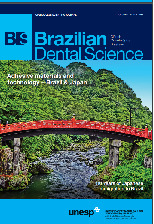Bone mineral density and mandibular osteoporotic alterations in type 2 diabetes
DOI:
https://doi.org/10.14295/bds.2018.v21i2.1587Resumo
Objective: To assess the influence of type 2 diabetes on bone mineral density in a group of type 2 diabetic patients, in comparison with non-diabetic patients. Additionally, to evaluate the correlation between mandibular cortical index and bone mineral density. Material and Methods: 48 patients (24 diabetics and 24 non-diabetics) referred for femur and spine densitometry and panoramic radiograph examination were included in this study. Patients were diagnosed based on densitometric results of the total femur and total spine. All panoramic radiomorphometric measurements were performed by 3 observers. Differences in T and Z-scores between both groups were evaluated with Mann-Whitney test and non-parametric correlations between mandibular cortical index and T/Z-scores were carried out with Spearman’s test. Results: Median T and Z-scores for total femur and total spine presented no statistical significant difference between diabetic and non-diabetic patients. In addition, only diabetics total femur and non-diabetics total spine T-scores were significantly correlated with mandibular cortical index. Conclusion: The present results suggest that type 2 diabetic patients have similar Z and T-scores in femur and spine when compared to non-diabetic patients. Mandibular cortical index, assessed on panoramic radiographs is inversely correlated with femur densitometry results in diabetics and spine bone mineral density in non-diabetic patients.
Keywords
Bone Mineral Density; Dual X-Ray Absorptiometry; Panoramic radiography; Osteoporosis; Type 2 Diabetes.
Downloads
Downloads
Publicado
Como Citar
Edição
Seção
Licença
TRANSFERÊNCIA DE DIREITOS AUTORAIS E DECLARAÇÃO DE RESPONSABILIDADE
Toda a propriedade de direitos autorais do artigo "____________________________________________________________________" é transferido do autor(es) para a CIÊNCIA ODONTOLÓGICA BRASILEIRA, no caso do trabalho ser publicado. O artigo não foi publicado em outro lugar e não foi submetido simultaneamente para publicação em outra revista.
Vimos por meio deste, atestar que trabalho é original e não apresenta dados manipulados, fraude ou plágio. Fizemos contribuição científica significativa para o estudo e estamos cientes dos dados apresentados e de acordo com a versão final do artigo. Assumimos total responsabilidade pelos aspectos éticos do estudo.
Este texto deve ser impresso e assinado por todos os autores. A versão digitalizada deverá ser apresentada como arquivo suplementar durante o processo de submissão.




























